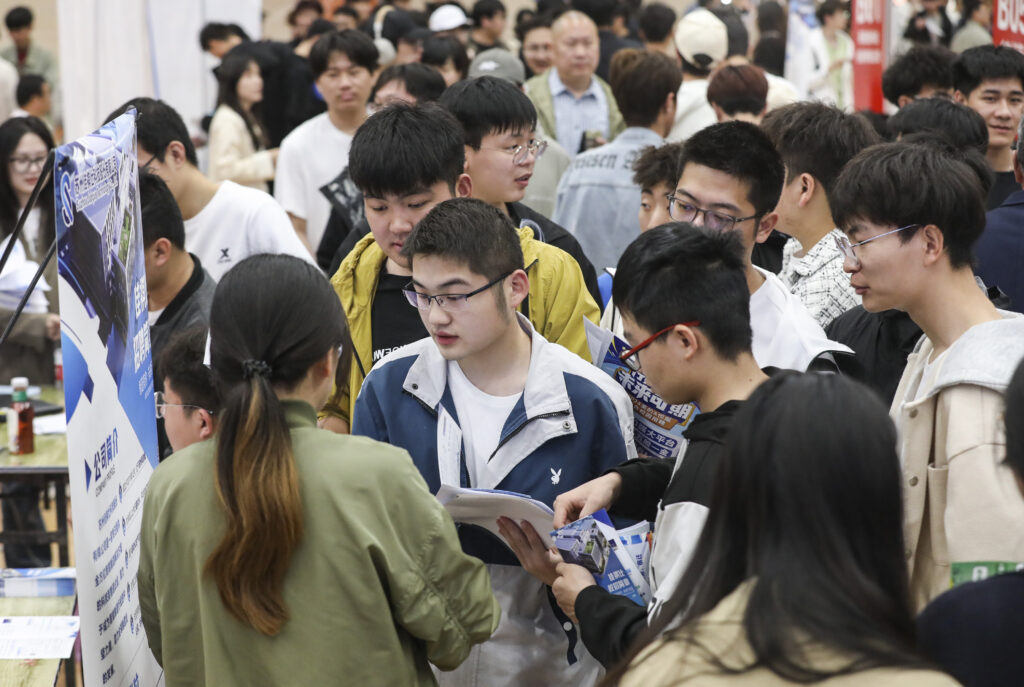China is experiencing both a cyclical and structural slowdown that makes it particularly challenging to assess whether its official growth and employment targets will be achieved in 2024.
In 2024, the Chinese government is aiming for around five per cent GDP growth and to create over 12 million new jobs. The employment figure has always been an important target, serving both to provide jobs for graduates and as a reflection of China’s shift from a low-cost manufacturing economy to one with larger services and high-value-added production sectors.
This deindustrialisation process is normally expected when a country reaches upper middle-income level, which is roughly where China is at. This shift should create jobs since the service sector is largely labour intensive. Though the advent of artificial intelligence might alter the capital and labour mix, it is still premature for that technology to dramatically alter the usual deindustrialisation pattern.
For instance, even though China downgraded its GDP growth target from 6–6.5 per cent in 2019 to around five per cent in 2024, the employment growth target was upgraded from 11 million to over 12 million during the same period. Before the COVID-19 lockdown in 2019, 13.5 million jobs were created, exceeding China’s employment target at the time. Annual urban employment had grown by more than 13 million for seven consecutive years until 2019.
By overshooting expected employment rates, the Chinese government may have gained some confidence in increasing the employment growth target even as they cut the GDP growth target. This aligns with expectations that when a country reaches upper middle-income level, its growth rate will slow since it has exhausted more of its ‘catch up’ growth potential.
But it is challenging to assess whether China’s potential growth rate is around five per cent as China’s deindustrialisation started during the 2008–2009 global financial crisis. This means that cyclical factors arising from the aftermath of the worldwide crisis negatively affected Chinese exports and dampened the economy during a critical period of its growth path.
The COVID-19 pandemic also coincided with a property crash, contributing to the cyclical downturn of the Chinese economy during a period of structural slowdown. Heightened geoeconomic tensions of the Trump administration in 2016, which continued albeit in a different form under the Biden administration, also negatively impacted exports and investments into and out of China. Compounding the challenges, regulatory actions around the property sector, online education and health care further introduced friction for businesses and worsened the cyclical downturn.
Disentangling the cyclical from the expected structural slowdown of the Chinese economy has been difficult in the past few years. For instance, some might see geopolitical issues as structural since US restrictions on Chinese access to technology could reduce China’s potential growth rate. Though the property bust is cyclical in nature, its negative impact on GDP could last several years, making it particularly challenging to disentangle the cyclical factors from the structural slowdown as China deindustrialises.
Peking University economist Yang Yao points out that even when Japan dominated innovation in important consumer sectors during the 1970s and 1980s, it only grew by 3.5 per cent on average between 1973 and 1993 until its historic property crash. At the time, Japan’s per capita GDP was double what China’s is now (US$12,000). This implies that China should be expected to grow more quickly than the then-second largest economy in the world.
Another factor to consider is the extent of monetary and fiscal policy support. China’s monetary policy is expected to moderately support the economy in 2024. For instance, the central bank has cut the five-year loan prime rate, a lending rate that banks and non-bank lenders use as a reference mark for issuing mortgages.
Most loans in China are short-term, five years or less, which are then rolled forward. This cut aims to support households by reducing the cost of their mortgage payments and helping them weather the property bust. More significantly, fiscal policy will boost growth. China is expected to increase government spending by 7.8 per cent in 2024.
Both sets of policies should help China reach its GDP growth target. The policy support is countering worsening cyclical factors, such as the slow burn property bust and ongoing geopolitical tensions.
Though it is difficult to distinguish between cyclical and structural factors, it seems that China is planning to borrow and spend to reach its 2024 GDP growth target. China is also likely to meet its employment growth target unless there are more shocks in 2024, which cannot be ruled out given the challenging macroeconomic environment in the world’s second largest economy.
Dr Linda Yueh is Fellow in Economics at St Edmund Hall, Oxford University and Adjunct Professor of Economics at London Business School.

